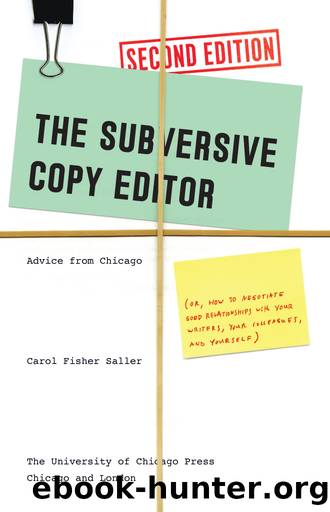The Subversive Copy Editor by Carol Fisher Saller

Author:Carol Fisher Saller [Saller, Carol Fisher]
Language: eng
Format: epub
ISBN: 9780226240107
Publisher: University of Chicago Press
Published: 2016-03-22T16:00:00+00:00
He pretty much nailed it—if we refine “when you don’t feel like it” to “when it’s not working.”
3. Is it ugly? There is the occasional instance in which a writer’s decision isn’t wrong or confusing, but, aesthetically speaking, you know it will lie badly on the page. For instance, a surfeit of numbers in running text can be an eyesore and tiresome to readers. The information might be better cast as a chart or table. On the other hand, material worked into tables is itself prone to ugliness: creating a table is far more difficult than criticizing or reshaping one that’s already been made, and the creator of the table is often too close to the data to perceive the reader’s problem with it. A long, skinny table might look better broken into two columns, for instance. Or sometimes a table’s side and top headings ought to be flipped to allow more room for longer headings. People might naturally disagree about such matters if they ultimately depend more on personal taste than expertise, but the point remains that a copy editor should consider modifying features that will put the reader off, even if it calls for a bit of extra effort.
Once you’ve considered a complex editing issue and decided it must be done, lean on two of the virtues we talked about in part 1: carefulness and transparency. The first helps prevent mistakes; the second will help you check your work and undo it if you get into a fix. I narrowly escaped trouble when I meddled with the initial capping of Shakespeare quotations in a book about the Bard. I started out tracking my changes “like this” and “Like this” for the writer’s benefit. But after I had marked enough to give the writer the idea of my method, I continued silently. If the writer had wanted his original system reinstated (luckily, he opted for Chicago’s style), I would have had to comb through the original document, carefully searching for the altered quotations (among many non-Shakespeare quotations that followed style), to find the errors. The transparency of redlining would have helped, but asking first (another kind of transparency) would have been better.
A third use of transparency is to send the writer a sample of the reworked material in order to show her what you’re doing before it’s too late to change your mind.
Download
This site does not store any files on its server. We only index and link to content provided by other sites. Please contact the content providers to delete copyright contents if any and email us, we'll remove relevant links or contents immediately.
Cecilia; Or, Memoirs of an Heiress — Volume 1 by Fanny Burney(32435)
Cecilia; Or, Memoirs of an Heiress — Volume 2 by Fanny Burney(31871)
Cecilia; Or, Memoirs of an Heiress — Volume 3 by Fanny Burney(31856)
The Lost Art of Listening by Michael P. Nichols(7408)
Asking the Right Questions: A Guide to Critical Thinking by M. Neil Browne & Stuart M. Keeley(5644)
We Need to Talk by Celeste Headlee(5544)
On Writing A Memoir of the Craft by Stephen King(4863)
Dialogue by Robert McKee(4323)
Pre-Suasion: A Revolutionary Way to Influence and Persuade by Robert Cialdini(4150)
I Have Something to Say: Mastering the Art of Public Speaking in an Age of Disconnection by John Bowe(3842)
Elements of Style 2017 by Richard De A'Morelli(3307)
The Book of Human Emotions by Tiffany Watt Smith(3238)
Fluent Forever: How to Learn Any Language Fast and Never Forget It by Gabriel Wyner(3031)
Name Book, The: Over 10,000 Names--Their Meanings, Origins, and Spiritual Significance by Astoria Dorothy(2940)
Good Humor, Bad Taste: A Sociology of the Joke by Kuipers Giselinde(2904)
Why I Write by George Orwell(2874)
The Art Of Deception by Kevin Mitnick(2736)
The Grammaring Guide to English Grammar with Exercises by Péter Simon(2711)
Ancient Worlds by Michael Scott(2626)
